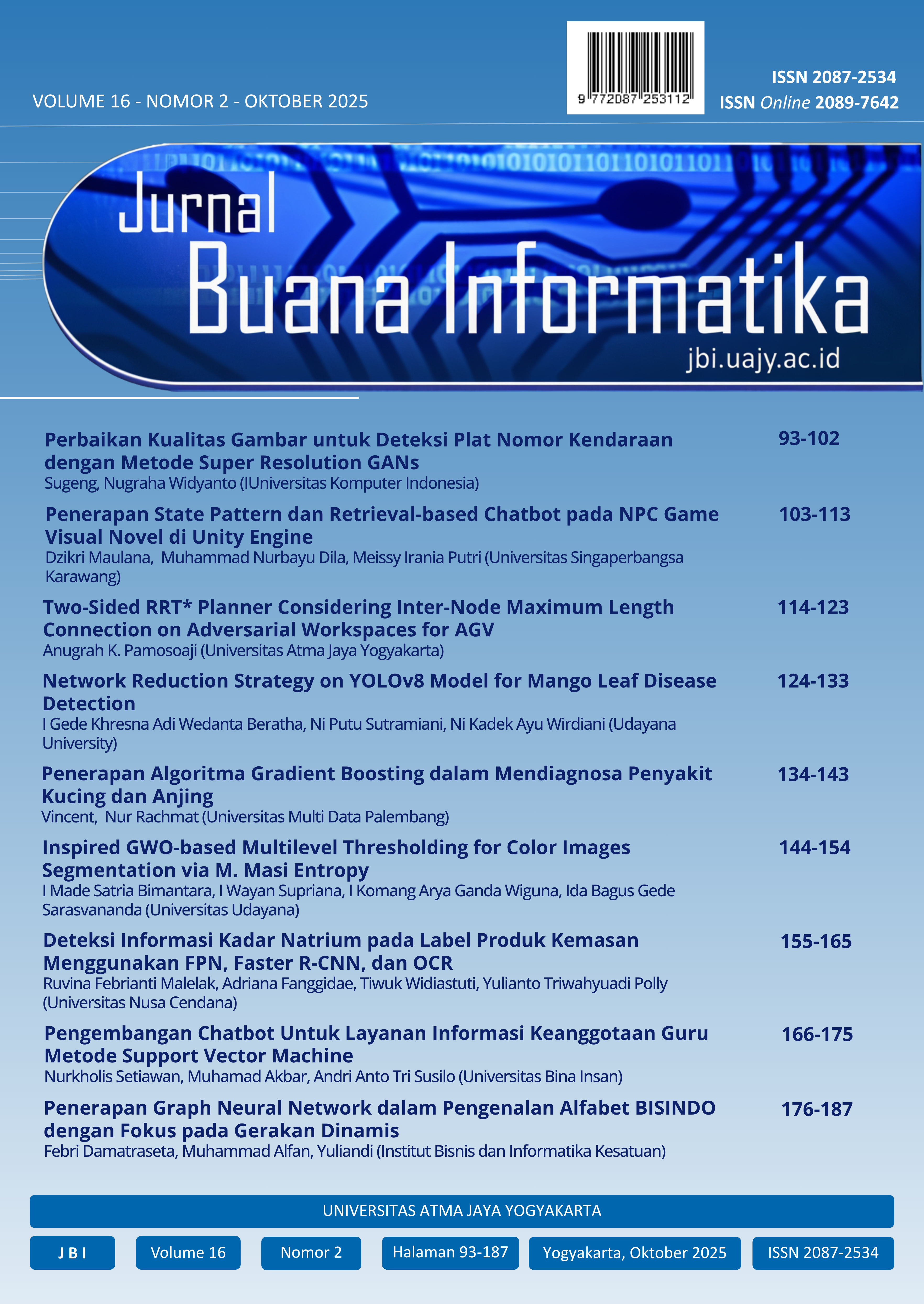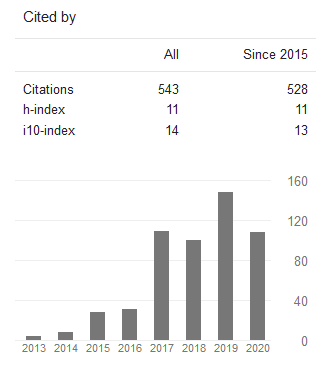Network Reduction Strategy on YOLOv8 Model for Mango Leaf Disease Detection
Keywords:
daun mangga, deteksi, pertanian, network reduction, YOLOv8, agriculture, detection, mango leavesAbstract
Detecting diseases on mango leaves is a crucial step in maintaining plant health and enhancing agricultural productivity, considering that leaves are one of the vital parts involved in the photosynthesis process and plant growth. Diseases that affect mango leaves can cause damage that hinders the growth of the plants, making the development of an accurate and efficient detection system essential to assist farmers in identifying and addressing these issues early on. The objective of this research is to develop a disease detection model for mango leaves using the YOLOv8 model optimized with a network reduction. The data used consists of images of mango leaves with four classes of diseases. The results of the study indicate that the optimized YOLOv8 model can produce a model with low complexity without compromising model performance. The model optimized with network reduction achieved the highest mAP50-95 value of 0.988, surpassing the baseline model by 0.3%.
References
D. Hidayat, “Klasifikasi Jenis Mangga Berdasarkan Bentuk Dan Tekstur Daun Menggunakan Metode Convolutional Neural Network (CNN),” Journal of Information Technology and Computer Science (INTECOMS), vol. 5, no. 1, pp. 98, 2022, doi: 10.31539/intecoms.v5i1.3401.
Badan Pusat Statistik, “Produksi Buah-buahan dan Sayuran Menurut Jenis Tanaman Menurut Provinsi,” 2023. [Online]. Available: https://www.bps.go.id/id/statistics-table/3/U0dKc1owczVSalJ5VFdOMWVETnlVRVJ6YlRJMFp6MDkjMw==/produksi-buah-buahan-menurut-jenis-tanaman-menurut-provinsi.html?year=2023 (accessed Jan. 12, 2025).
P. A. Widjaja and J. R. Leonesta, “Differentiate a Health and Sick of Mango Leaves Using YOLOv4,” Formosa Journal of Science and Technology, vol. 2, no. 7, pp. 1749–1758, Jul. 2023, doi: 10.55927/fjst.v2i7.4792.
Krishnamoorthy, L. V. N. Prasad, C. S. P. Kumar, B. Subedi, H. B. Abraha, and V. E. Sathishkumar, “Rice leaf diseases prediction using deep neural networks with transfer learning,” Environ Res, vol. 198, Jul. 2021, doi: 10.1016/j.envres.2021.111275.
A. TiaraSari and E. Haryatmi, “Penerapan Convolutional Neural Network Deep Learning dalam Pendeteksian Citra Biji Jagung Kering,” Jurnal Rekayasa Sistem dan Teknologi Informasi (RESTI), vol. 5, no. 2, pp. 265–271, Apr. 2021, doi: 10.29207/resti.v5i2.3040.
A. Cardellicchio et al., “Detection of tomato plant phenotyping traits using YOLOv5-based single stage detectors,” Computers and Electronics in Agriculture, vol. 207, Apr. 2023, doi: 10.1016/j.compag.2023.107757.
P. T. Ompusunggu, “Klasifikasi Penyakit Tanaman Pada Daun Kentang Dengan Metode Convolutional Neural Network Arsitektur Mobilenet,” Jurnal Syntax Fusion, vol. 2, no. 09, pp. 740–751, Sep. 2022, doi: 10.54543/fusion.v2i09.217.
Mutia Fadhilla, D. Suryani, A. Labellapansa, and H. Gunawan, “Corn Leaf Diseases Recognition Based on Convolutional Neural Network,” IT Journal Research and Development, vol. 8, no. 1, pp. 14–21, Aug. 2023, doi: 10.25299/itjrd.2023.13904.
F. Agustina and M. Sukron, “Deteksi Kematangan Buah Pepaya Menggunakan Algoritma YOLO Berbasis Android,” Journal Informasi Komputer Akuntansi dan Manajemen, vol. 18, no. 2, Sep. 2022.
L. Setiana Riva and Jayanta, “Deteksi Penyakit Tanaman Cabai Menggunakan Algoritma YOLOv5 Dengan Variasi Pembagian Data,” Jurnal Informatika: Jurnal pengembangan IT (JPIT), vol. 8, no. 3, Sep. 2023.
S. B. Mamun, I. J. Payel, M. T. Ahad, A. S. Atkins, B. Song, and Y. Li, “Grape Guard: A YOLO-based mobile application for detecting grape leaf diseases,” Journal of Electronic Science and Technology, vol. 23, no. 1, Mar. 2025, doi: 10.1016/j.jnlest.2025.100300.
P. A. Widjaja and J. R. Leonesta, “Determining Mango Plant Types Using YOLOv4,” Formosa Journal of Science and Technology, vol. 1, no. 8, pp. 1143–1150, Dec. 2022, doi: 10.55927/fjst.v1i8.2155.
A. Wibowo, L. Lusiana, and T. K. Dewi, “Implementasi Algoritma Deep Learning You Only Look Once (YOLOv5) Untuk Deteksi Buah Segar Dan Busuk,” Paspalum: Jurnal Ilmiah Pertanian, vol. 11, no. 1, p. 123, Mar. 2023, doi: 10.35138/paspalum.v11i1.489.
S. Aras, P. Tanra, and M. Bazhar, “Deteksi Tingkat Kematangan Buah Tomat Menggunakan YOLOv5,” MALCOM: Indonesian Journal of Machine Learning and Computer Science, vol. 4, no. 2, pp. 623–628, Mar. 2024, doi: 10.57152/malcom.v4i2.1270.
I. N. Piarsa, N. P. Sutramiani, and I. W. A. Surya Darma, “Network Reduction Strategy and Deep Ensemble Learning for Blood Cell Detection,” Lontar Komputer : Jurnal Ilmiah Teknologi Informasi, vol. 14, no. 3, p. 161, Dec. 2023, doi: 10.24843/lkjiti.2023.v14.i03.p04.
I. W. A. S. Darma, N. Suciati, and D. Siahaan, “CARVING-DETC: A network scaling and NMS ensemble for Balinese carving motif detection method,” Visual Informatics, vol. 7, no. 3, pp. 1–10, Sep. 2023, doi: 10.1016/j.visinf.2023.05.004.
A. A. Rasjid, B. Rahmat, and A. N. Sihananto, “Implementasi YOLOv8 Pada Robot Deteksi Objek,” Journal of Technology and System Information, vol. 1, no. 3, p. 9, Jul. 2024, doi: 10.47134/jtsi.v1i3.2969.
Abin Timilsina, “YOLOv8 Architecture Explained,” Mar. 17, 2024. [Online]. Available:https://abintimilsina.medium.com/yolov8-architecture-explained-a5e90a560ce5 (accessed Aug. 17, 2025).
A. Y. Nugroho and F. Kristanto, “Mengejar Kinerja Maksimal: Teknik Pengoptimalan Terkini dalam Pembelajaran Mesin,” Jurnal Penelitian Teknologi Informasi dan Sains, vol. 2, no. 3, pp. 59–69, Aug. 2024, doi: 10.54066/jptis.v2i3.2358.
S. Ali et al., “MangoLeafBD Dataset.” [Online]. Available: https://www.kaggle.com/datasets/aryashah2k/mango-leaf-disease-dataset (accessed Oct. 24, 2024).
Downloads
Published
Issue
Section
License

This work is licensed under a Creative Commons Attribution-ShareAlike 4.0 International License.
Copyright of this journal is assigned to Jurnal Buana Informatika as the journal publisher by the knowledge of author, whilst the moral right of the publication belongs to author. Every printed and electronic publications are open access for educational purposes, research, and library. The editorial board is not responsible for copyright violation to the other than them aims mentioned before. The reproduction of any part of this journal (printed or online) will be allowed only with a written permission from Jurnal Buana Informatika.
This work is licensed under a Creative Commons Attribution-ShareAlike 4.0 International License.










